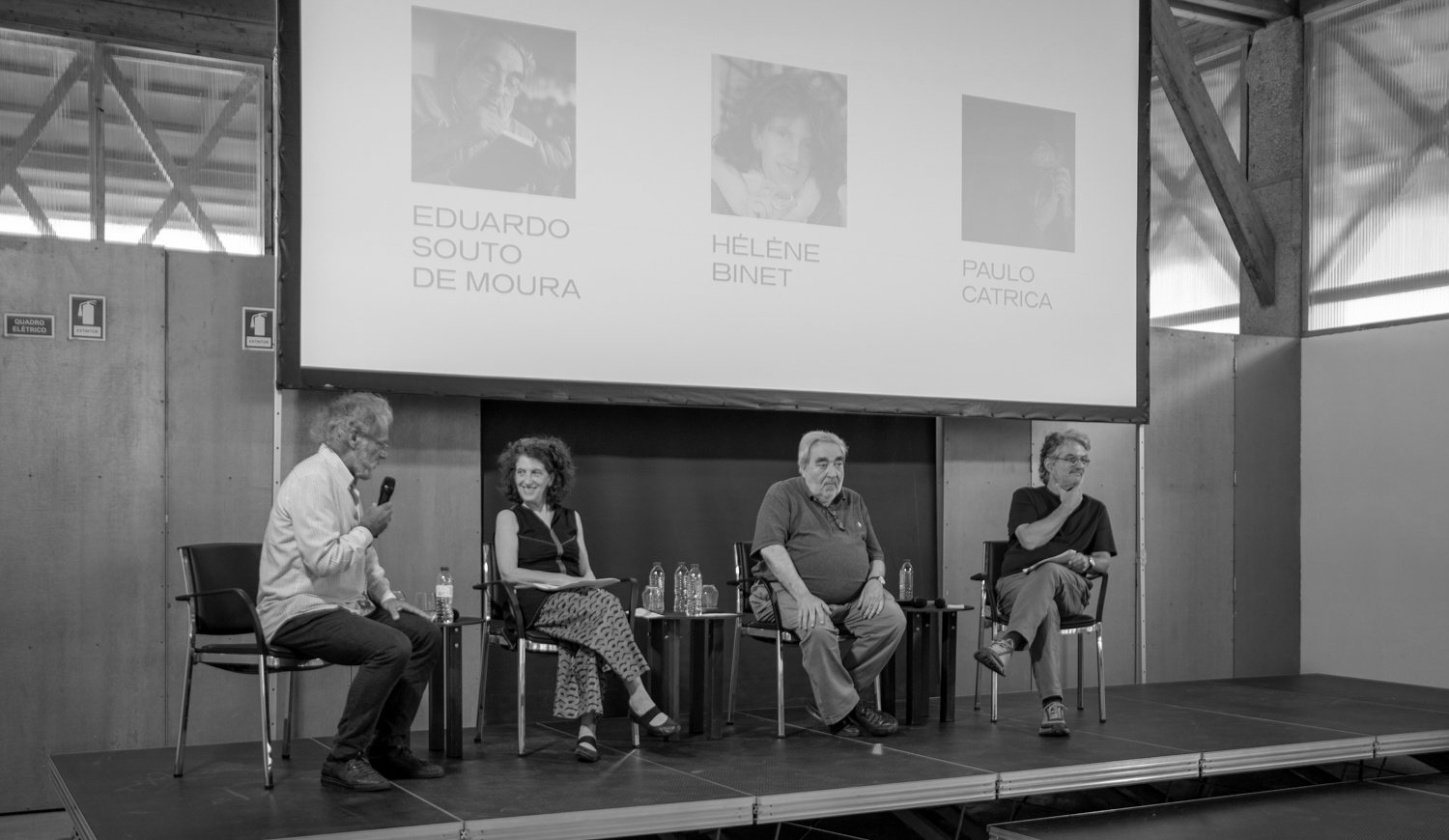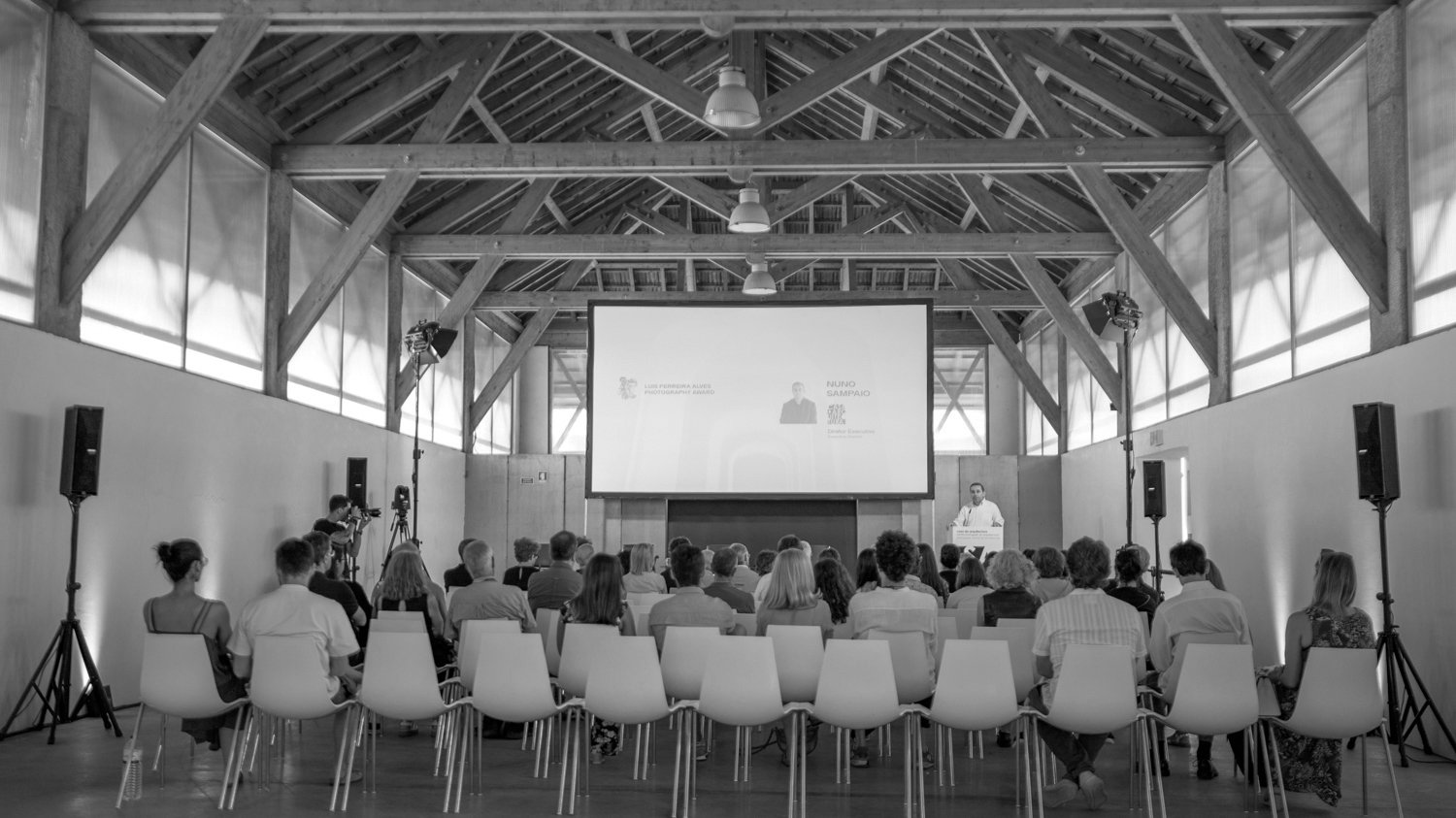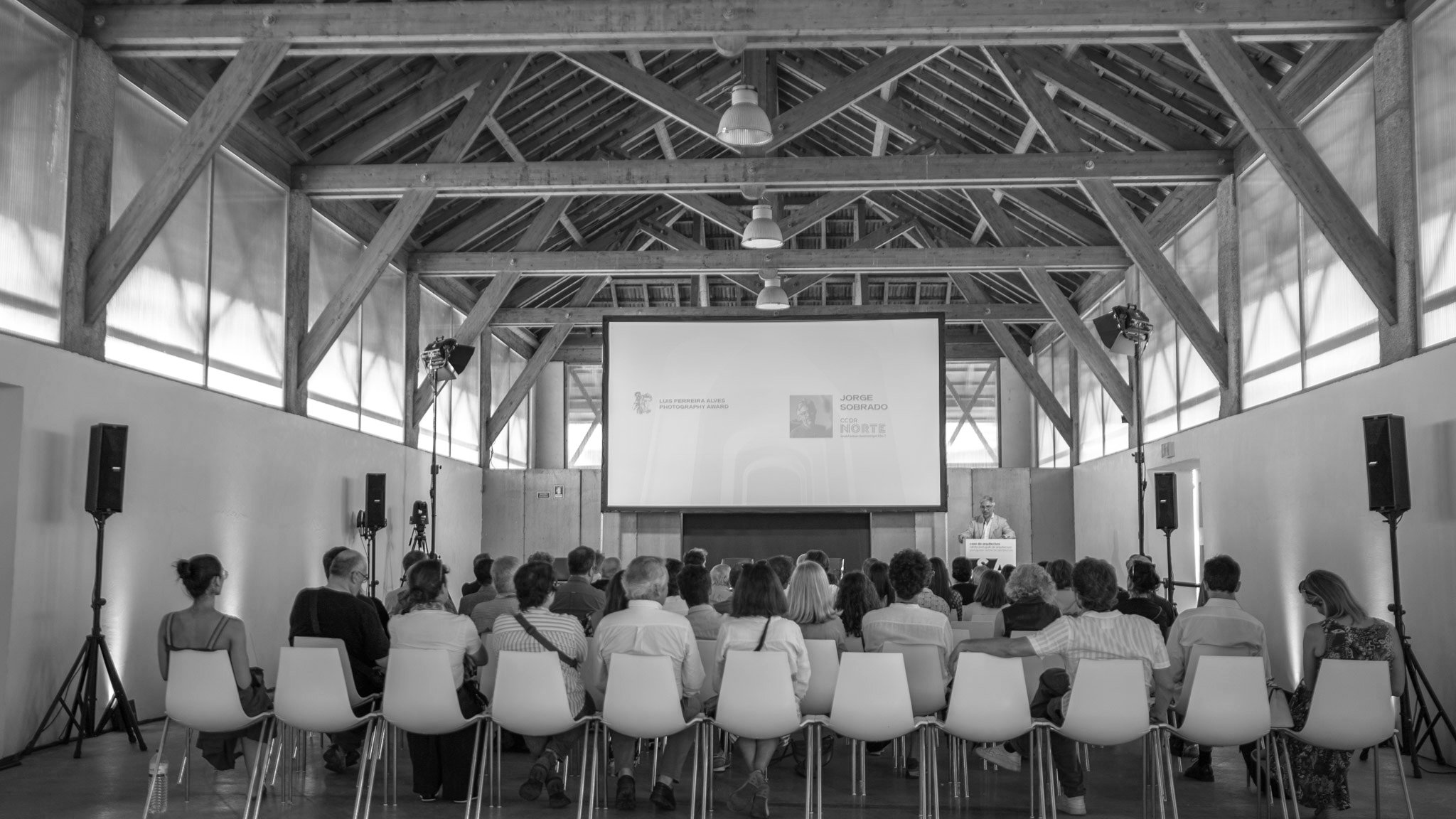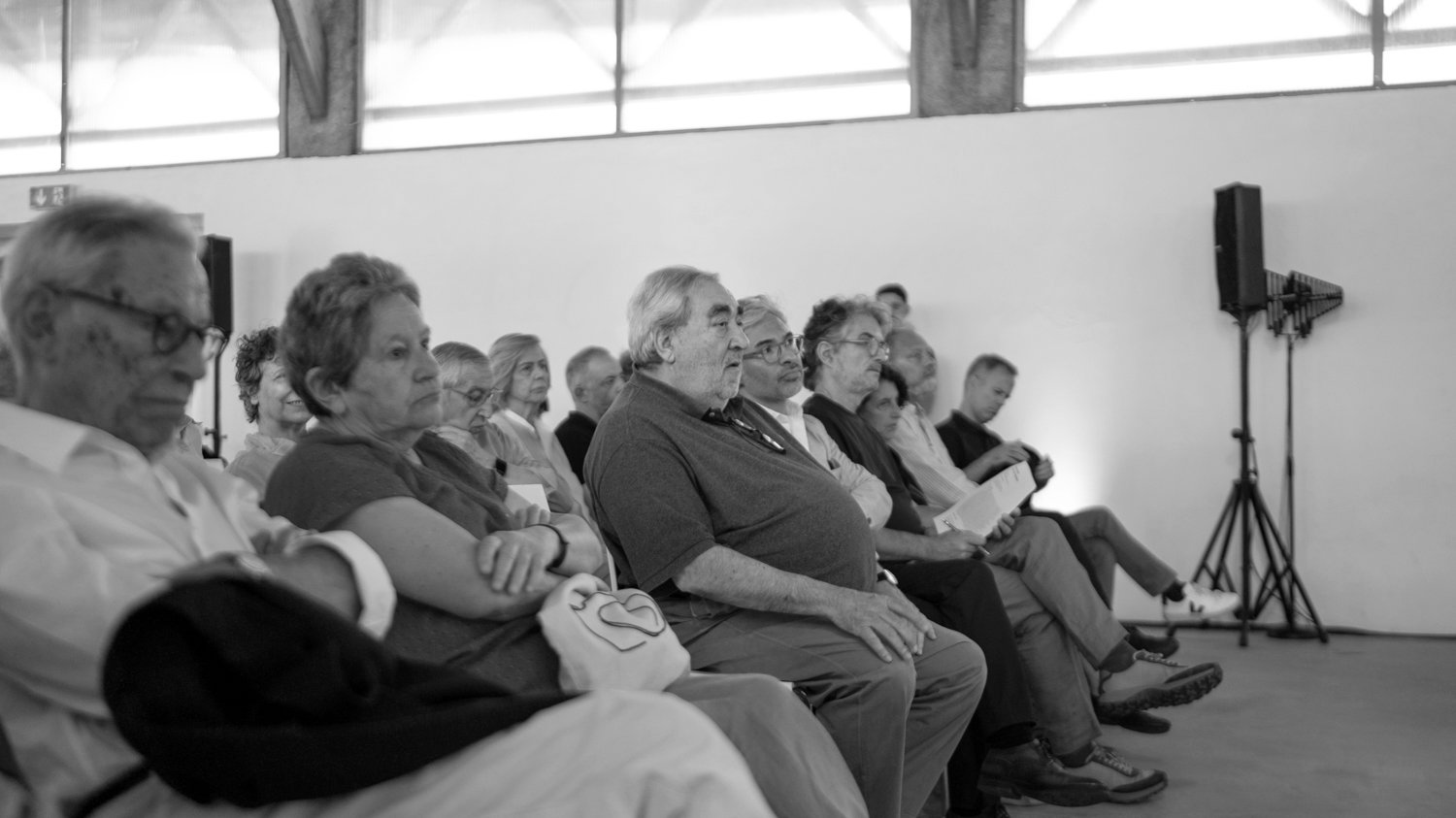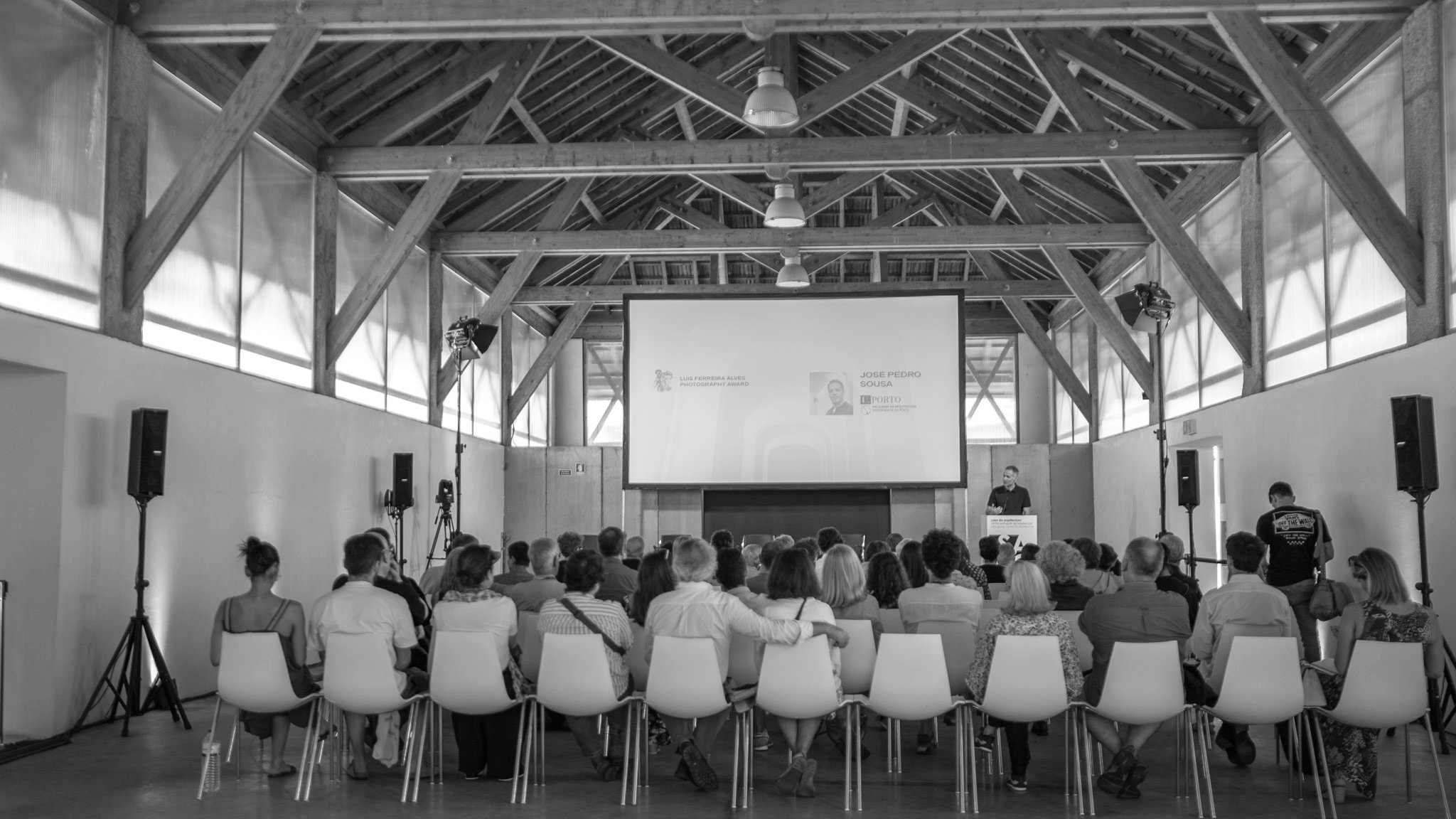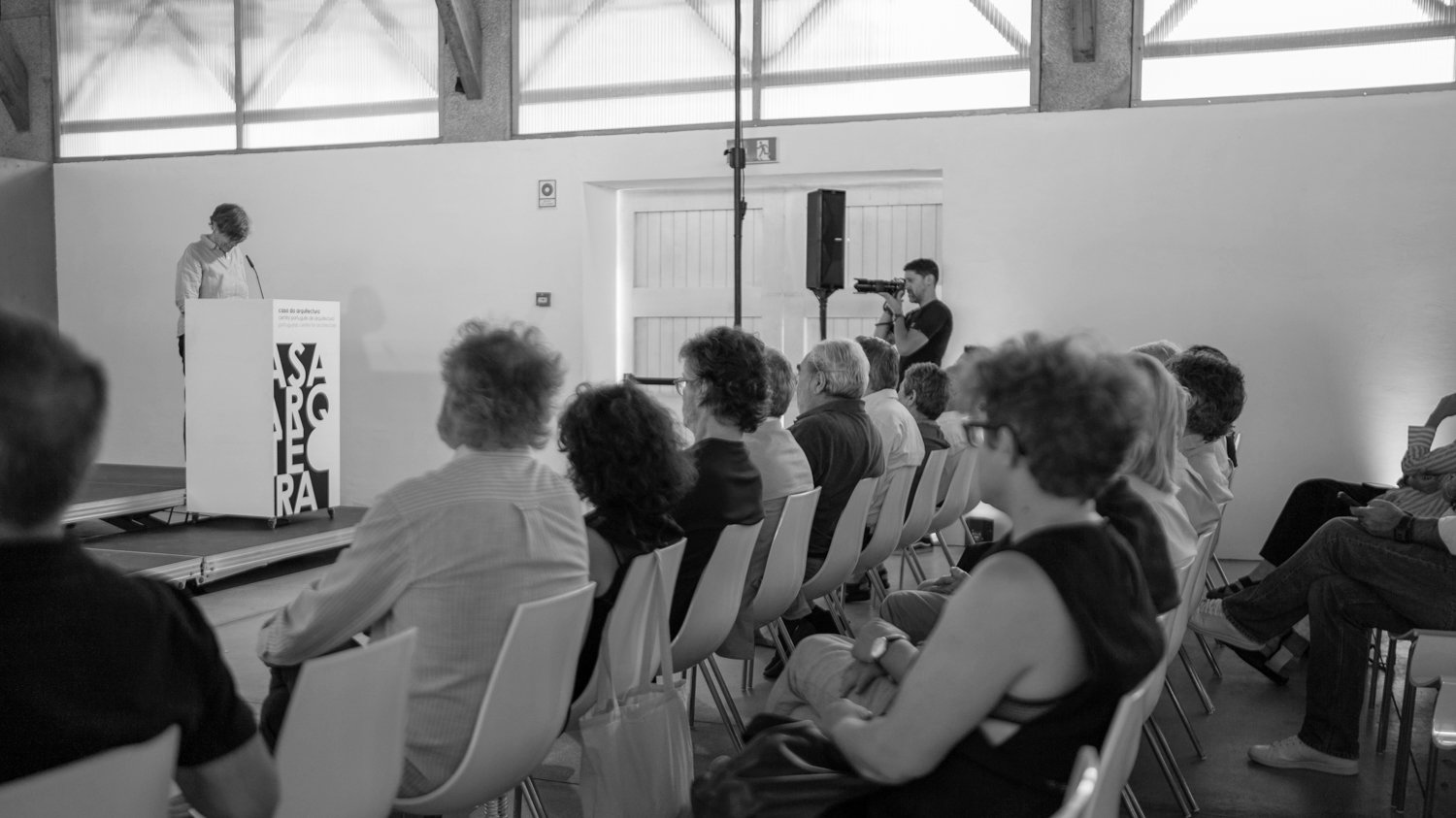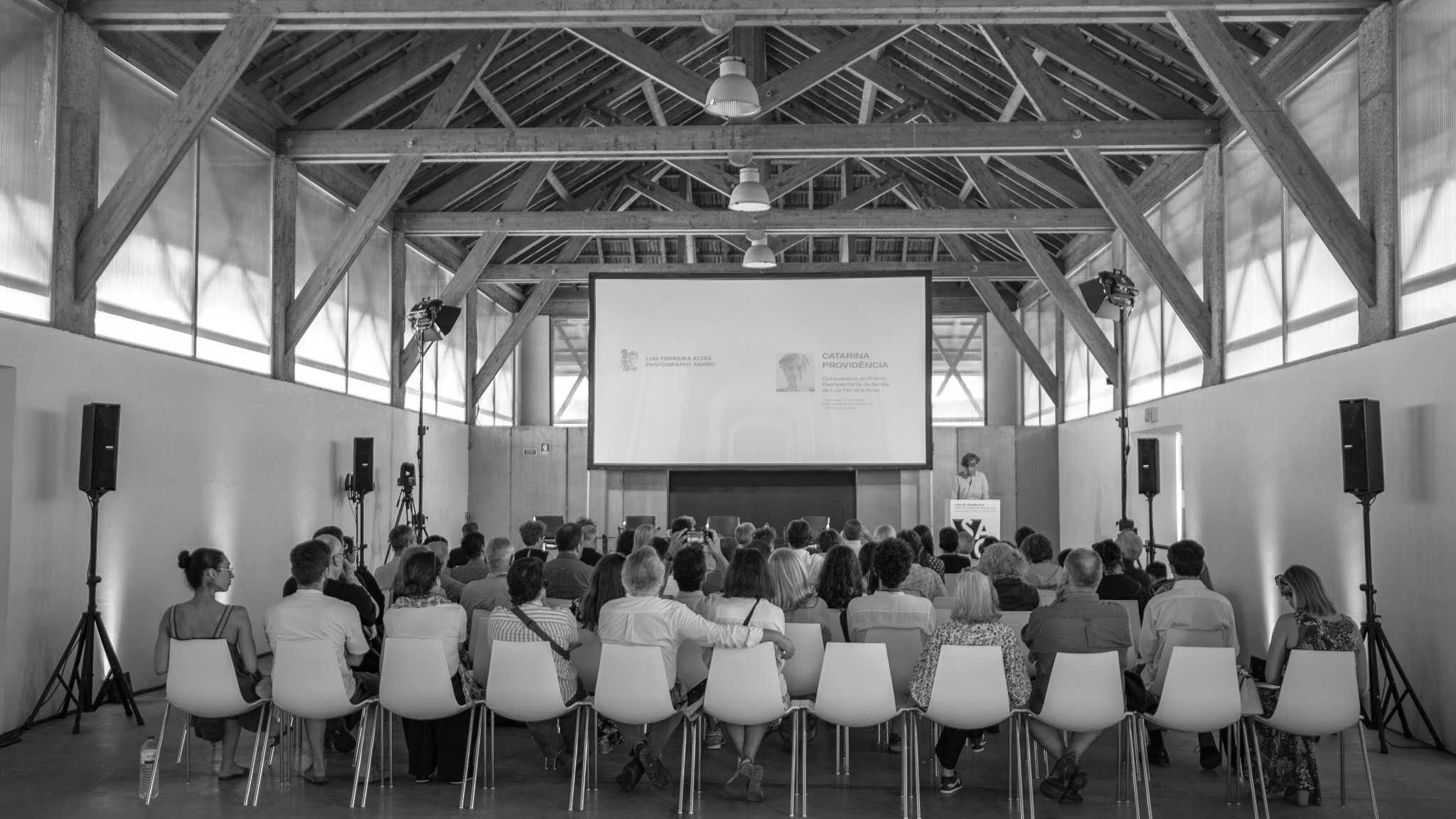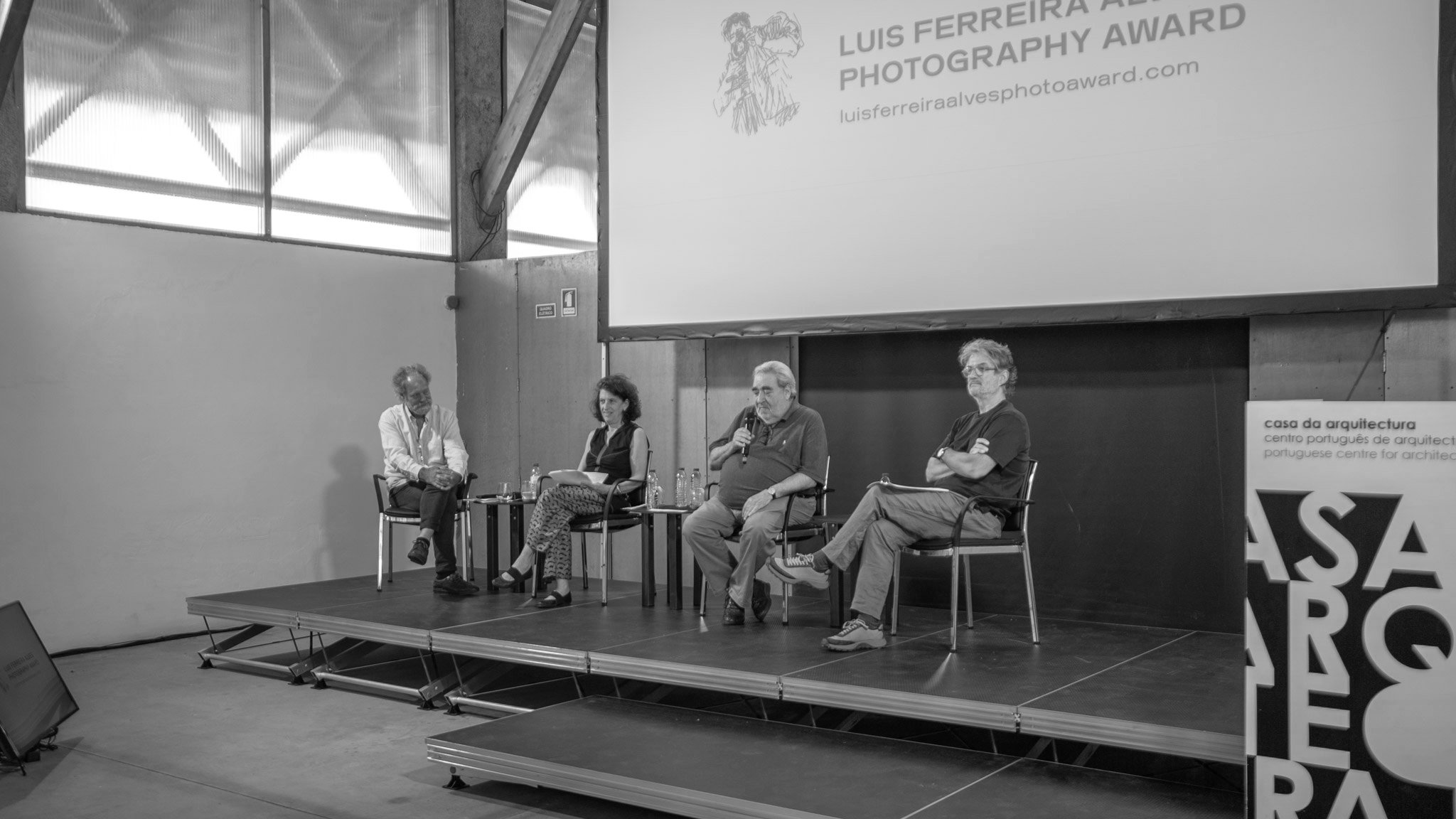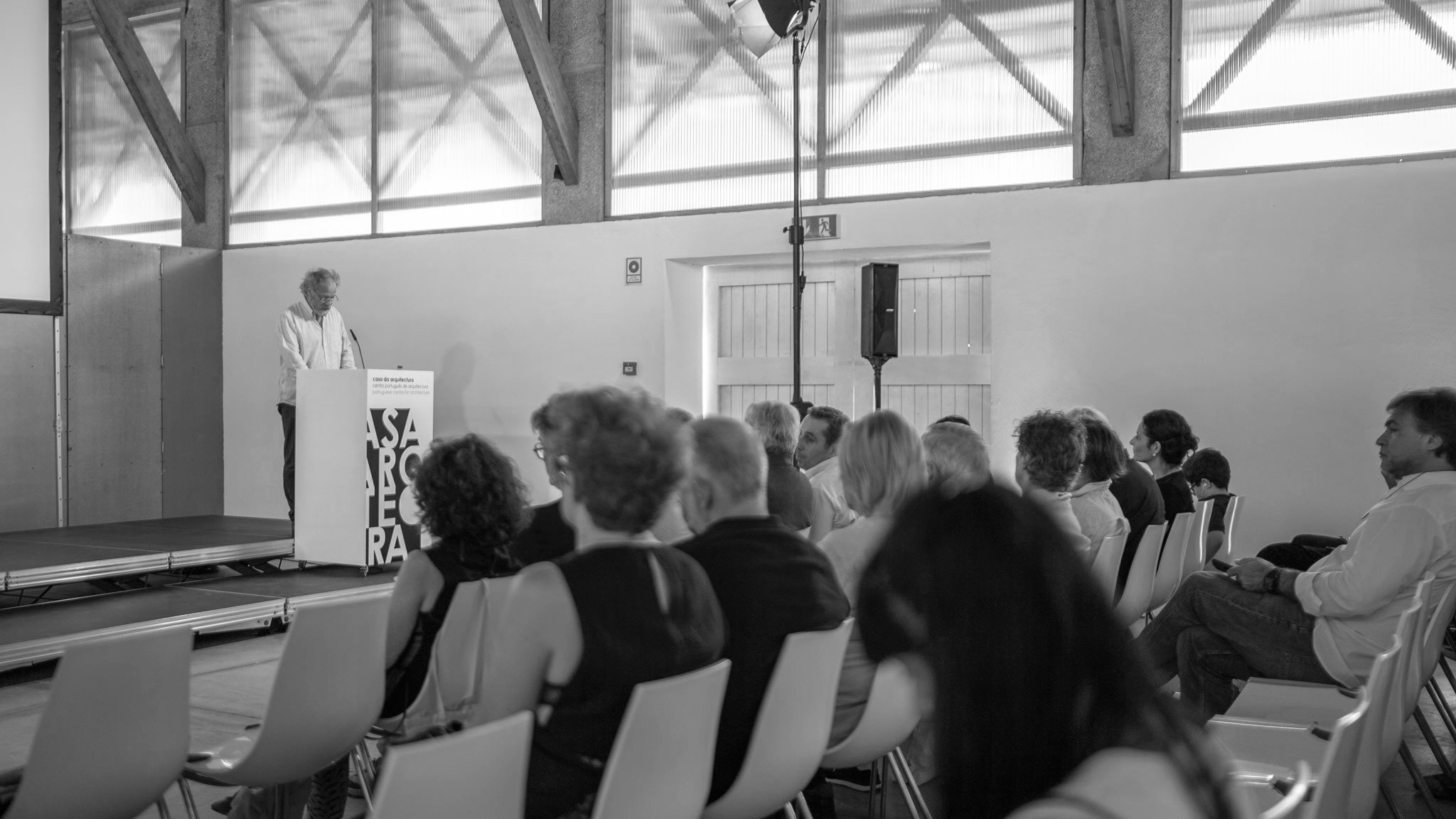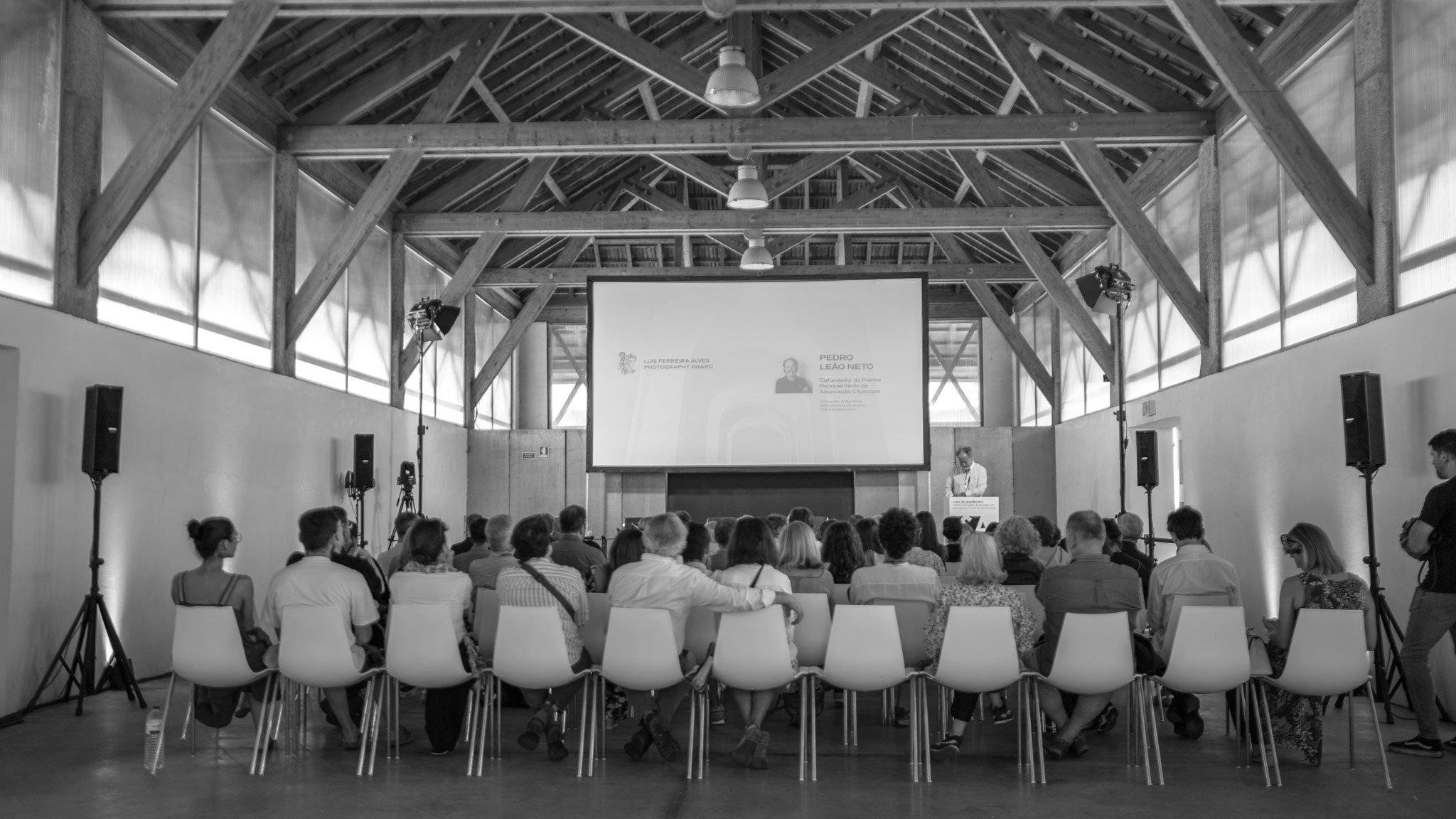Luis Ferreira Alves Award celebrates excellence in architectural photography with a well-attended ceremony at Casa da Arquitectura
On 28 June 2025, in Matosinhos, the central pavilion of Casa da Arquitectura hosted the award ceremony for the Luis Ferreira Alves International Photography Award. The event was distinguished by the strong attendance of architects, photographers, students, institutional representatives and the general public, as well as by the strong presence of the honoree's family - children, grandchildren and his widow and co-founder of the prize, Catarina Providência.
The session combined a screening of the winning photographic series, institutional interventions and a meeting with the members of the competition jury: architect Eduardo Souto de Moura, photographers Hélène Binet and Paulo Catrica, and the coordinator and curator of the prize, Pedro Leão Neto.
A shared tribute between memory and future
The session was opened by Nuno Sampaio, executive director of Casa da Arquitectura, host of the event and strategic partner of the prize. In his speech, Nuno Sampaio emphasised Luis Ferreira Alves' deep emotional and institutional ties with the Casa, which houses his photographic collection and named the Luis Ferreira Alves Gallery after him, a space dedicated to architectural photography.
He recalled memorable moments in this relationship - namely the exhibition dedicated to the photographer, held during his lifetime, and the ceremony to award him the Medal of Cultural Merit, given by the Portuguese State on the Casa's premises.
For Nuno Sampaio, this award is not only a fitting tribute to the memory of a key figure in Portuguese visual culture, but also a way of recognising the decisive role that photography plays in the dissemination and appreciation of architecture:
‘Luis helped make known to the world what Portuguese architecture was - and is.’
He also noted the success of the first edition of the prize, reflected in the high number and quality of international entries, and praised the organisation's efforts to build a project with ambition, rigour and lasting relevance.
Daniela Fernandes, representing Porto City Council, emphasised the municipality's pride in promoting the initiative since its inception. She emphasised the international dimension achieved in the first edition and the relevance of the prize in the context of valuing architecture and photography as cultural expressions and tools for critically reading the city and its territory.
He also announced that, as a way of prolonging the impact of the prize, in September the City Council will organise a public exhibition of the winning works in the old Town Hall, in a gesture that symbolically brings Luis Ferreira Alves closer to the figure of Fernando Távora, the master with whom he worked continuously.
In her brief but significant speech, Daniela Fernandes also praised the work of the organisation and the generosity of the photographer's family, highlighting the importance of preserving and revisiting his records - such as those made during the renovation of Casa do Infante, home to the Municipal Historical Archive.
Jorge Sobrado, vice-president of the Northern Regional Coordination and Development Commission (CCDR-N), gave a reflective speech in which he evoked the writer Robert Musil, quoting a phrase that he considers both paradoxical and revealing: ‘There is nothing more invisible than a monument.’ Based on this idea, he drew a parallel with architecture, which, despite apparently imposing itself through its physical presence, does not reveal itself immediately or automatically. ‘Neither cultural heritage nor architecture impose themselves - they need mediums, means, interpreters,’ he said. In this context, Jorge Sobrado emphasised the role of photography as an essential medium, and Luis Ferreira Alves as one of the great ‘architectural mediums’. It was this quality that justified, for the CCDR-N official, the creation of the award: not as a gesture of consecration, but as a collective call for reflection, shared in a network of institutional and cultural partners. In this sense, he praised the determination of the Cityscopio Cultural Association, led by Pedro Leão Neto and Catarina Providência, ‘for having unsettled and misled us’, leading everyone involved to set up this joint project.
‘Nothing is as invisible as architecture... except with photography.’
José Pedro Sousa, architect and professor at the Faculty of Architecture of the University of Porto (FAUP), emphasised the central role that photography plays in contemporary architectural culture. Far from being limited to a documentary record, he argued, photography today is a form of interpretation, criticism and communication, capable of expressing essential dimensions of architecture, such as light, scale, time or materiality.
Quoting the photographer Hélène Binet, he emphasised that ‘photography does not show architecture as it is, but as it can be felt and understood’, highlighting its emotional and interpretative power. He also referred to Beatriz Colomina's thinking, according to which architecture no longer exists only in its physical dimension, but also - and increasingly - in its image.
It is in this context that he placed the relevance of the Luis Ferreira Alves Prize, as a project that promotes a critical, sensitive and poetic approach to architecture. The FAUP, he said, naturally joined in organising the prize, not only to pay tribute to the figure and work of Luis Ferreira Alves, but also to reinforce the place of photography as an instrument for producing and disseminating architectural knowledge.
In a moment of personal recognition, José Pedro Sousa highlighted the work of Pedro Leão Neto, professor, researcher and coordinator of the prize, whose career has been characterised by the intersection between photography, image and architecture. ‘His career has been decisive for the valorisation of this field, both inside and outside academia,’ he said, noting the contribution he has made to consolidating photography as a transversal discipline in the thinking and teaching of architecture.
On behalf of FAUP, he concluded with the school's commitment to continuing to support the prize and to promoting the debate around the role of the image in the construction of architectural discourse.
The voice of origin and emotion: Catarina Providência and Pedro Leão Neto
Catarina Providência's speech was one of the most moving moments of the event. Taking the floor on behalf of Luis Ferreira Alves' family, in an intimate and eloquent record, she drew a vivid and moving portrait of the photographer, a multifaceted man, passionate about life, ideas and people, who lived his many interests intensely - from photography to cinema, from politics to sailing, from motorbikes to philosophy.
She recalled his commitment to freedom in times of dictatorship, his admiration for Fernão de Magalhães and his pride in Portuguese history. In a symbolic analogy, he evoked Cantino's Planisphere - one of the first representations of the known world in the 16th century - as an image of a prize that, six centuries later, has also managed to ‘circumnavigate the planet’, receiving works from photographers on every continent.
‘Wherever his spirit is, Luis will have been moved to see photographers from all over the world mobilised in his honour,’ he said.
With gratitude and generosity, he thanked the jury, the partners, the funders and, above all, the 1,495 participants who gave substance to the ambition of transforming memory into a collective creative act, concluding on a note of affection:
"It has been an adventure to share 30 years of Luis' happy and exciting life. This award extends that legacy."
The speech by Pedro Leão Neto, architect, FAUP professor and coordinator of the prize, was one of the structuring moments of the ceremony, as he outlined the conceptual and operational bases of the initiative. In a dense and emotional speech, he thanked and praised the fundamental role of Catarina Providência, the photographer's widow and co-founder of the prize, whose support from the outset was decisive, declaring that ‘Without her dedication and vision, the prize would not have the strength or significance it has today’. He also thanked Casa da Arquitectura, in the name of its executive director, Nuno Sampaio, for its strategic support and hospitality, emphasising the importance of hosting the prize in a space with which Luis Ferreira Alves had a deep and symbolic connection.
Pedro Leão Neto highlighted the importance of the award as a gesture of resistance against the superficiality of contemporary fast-moving and decontextualised images. ‘There is still a desire to stop and look, to reflect,’ he said, pointing out that the essence of the competition lies in the construction of visual narratives that approach architecture as a process, territory and idea, and not simply as an isolated object.
Evoking the uniqueness of Luis Ferreira Alves' approach, he emphasised that the photographer was always looking for the light, the material, the context and the life around the architectural work. "His images communicate that architecture is not an end, but a journey. And it was this critical, poetic and relational dimension that we wanted to transpose into the award's regulations," he explained.
He also recognised the contribution of all the institutional partners, with a special focus on the main promoter of the prize, Porto City Council, also mentioning the other important institutional partners from CCDR-N, FAUP, Fundação Marques da Silva, Ordem dos Arquitetos and sponsors of the winners CIN brand, La Caixa - BPI and Canon, as well as strategic communication partners Metro do Porto and AMAG
Finally, he emphasised the exceptional nature of the participation: 1. 495 entries from 99 countries, confirming the global impact of the initiative and the relevance of its purpose and, in a final appeal for the continuity and critical demand of the prize, he referred to architectural photography as an essential field of mediation between architectural creation and the public eye, ‘an antidote to the trivialisation of the image and a platform for thought’.
The eyes of the jury members: The winners: three visions, three geographies
Hélène Binet and photography as poetic enquiry
The prestigious photographer Hélène Binet, one of the most influential voices in architectural photography worldwide, was in charge of presenting the first two award winners. Her speech proved to be a moment of aesthetic and critical reflection that reaffirmed the prize's mission as a space for thought and visual experimentation.
Announcing the 1st Prize, awarded to Iranian photographer Maho for his Paradise Town series, Hélène Binet emphasised the maturity and narrative complexity of the project. Realised in a satellite town on the outskirts of Tehran, the work is distinguished, in her words, by a ‘delicate tension between the portrait of architecture and its socio-political reading’.
The series features moderate-scale multi-family dwellings, whose shapes are captured in an arrangement that favours a horizontal reading of the whole - a compositional choice reinforced by the imposing presence of the Damavand Mountains on the horizon. By returning to the same place several times, Maho captures the seasonal transformation of light, landscape and atmosphere, giving the project an almost musical visual structure, ‘like a poem’, in the words of the juror.
More than a formal representation, Paradise Town reveals itself, according to Hélène Binet, as a critical study of inhabited space: the absence of urban infrastructure, the functional precariousness of the spaces and the minimal gestures of appropriation - such as a wall transformed into a support for maths lesson announcements - reveal an architecture that, while banal, speaks of hope, resilience and an attempt at community life.
"This work isn't just pictorial, or beautiful and technically perfect. It's a subtle way of making us understand what we're seeing. It's criticism, observation and empathy."
At the presentation of the 2nd Prize, awarded to Frenchman Cyril Weiner, Hélène Binet highlighted the delicacy and coherence of a series that delves into the ephemeral universe of temporary spaces linked to theatre and the circus. Rather than glorifying architectural icons, Weiner takes us into unexpected territories - structures that host shows, built to last only a short time, but full of emotional and symbolic meaning.
The exterior images, captured in winter under soft, restrained light, convey the fragility of these volumes, while the interiors reveal a silent narrative: from the lighting installation to the technical backstage, from the discreet gestures of the technicians to the expectant emptiness before the performance.
"These spaces remind us of Fellini's cinema - that magical world of light and shadow where we tell stories about ourselves. They are architectures of imagination, where matter disappears to make way for suggestion."
Hélène Binet also emphasised that what impressed the jury most about both works was their narrative strength. More than just beautiful images, they are cohesive series with rhythm, depth and intention - projects that assert themselves as forms of investigation, not just representation.
"A good photograph is one thing. A coherent and meaningful series is another. And that's what struck us - the ability to tell stories through architecture."
With these words, Hélène Binet reiterated the nature of the prize as a space of resistance to contemporary visual speed, drawing attention to architectural photography as an autonomous, demanding discipline that is deeply connected to the world we inhabit.
A provisional atlas of Berlin: the insistent gaze of Sergio Belinchón
Pedro Leão Neto presented the 3rd prize-winning project by Spanish visual artist and photographer Sergio Belinchón, who has lived in Berlin for several years, for the series Provisional Atlas of Berlin. The work, the result of four years of continuous visual research, was described as a work of remarkable formal and conceptual consistency, which moves away from an episodic perspective to build a cohesive visual narrative about a city in permanent mutation.
He highlighted the author's approach to architecture as both document and symptom, revealing the tensions of contemporary Berlin: between scales, between programmes, between overlapping historical times. With a limited set of seven images - as stipulated in the regulations - Sergio Belinchón managed, according to the coordinator of the prize, to ‘clearly and subtly communicate the social and spatial transitions of a city that remains restless, marked by layers of memory, destruction and reinvention.’
The images avoid the grandiose or the spectacular: there are no monuments or central human figures. What you see are signs - fragments of space, traces of use, surfaces marked by the passage of time, which give an account of urban life without directly representing it. ‘People don't appear, but they make themselves felt in the signs they leave behind,’ emphasised Pedro Leão Neto, referring to the indicative nature of the series.
From a technical point of view, he also highlighted the compositional rigour and mastery of light, as well as the ability to balance a documentary reading with an autonomous visual language, capable of transcending mere recording.
Eduardo Souto de Moura, a member of the jury and an internationally renowned author, spoke next to comment on the award and emphasise the importance of the selected work.
He revealed that he had suggested the work for the award early on, recognising that there were initial reservations about the originality of the theme, given the profusion of photographic representations of Berlin. However, ‘the coherence between the images and the author's quiet and rigorous approach ended up convincing us all,’ he said, emphasising the value of the project and the consensus reached within the jury.
"There are those who say that this topic has already been exhausted. That Berlin has been seen and reviewed. But that's exactly why I was struck by the way these images managed to escape the cliché, without resorting to forced strategies. There is a remarkable coherence here, a silent unity that grips you. I fought for it."
With this statement, Souto de Moura summarised the essence of the project: a disciplined, attentive and restrained gaze that avoids excess and drama to reveal architecture as a social palimpsest, where past and present overlap in a dense but not explicit way.
Special mentions: new geographies and new voices
Paulo Catrica presented the two special mentions awarded by the jury to works by female photographers - a conscious decision, according to him, which also aimed to highlight the under-representation of women in architectural photography and the unique contribution of their gaze.
The first mention honoured the young Iranian Sana Ahmadizadeh, author of the Hidden Land project. In her words, it is a ‘small model of contemporary Iran’, where archaeology, memory and repression intertwine. The images document a landscape that hides layers of Iranian history under vegetation and the ruins of ancient cities and buildings that are now off-limits.
Catrica read out an extract from the author:
‘This place is a small model of contemporary Iran, buildings buried under vegetation, the remains of devices that have been tarnished or eliminated due to the new government's rules... I returned as a foreigner to better understand the convergence of periods of history and the place where I once lived.’
The second award went to Amélia Lancaster, architect and visual artist, for her work on the National Theatre in London by architect Denys Lasdun.
According to Eduardo Souto de Moura, who supported the award, this is ‘an abstract work based on reality’, divided into three sub-sets - Beautiful Brutalism, Reduction and Negatives - which, through chromatic manipulation and contrast, reconfigure the perception of the brutalist building. ‘It's beautiful,’ said Souto de Moura, adding that part of this work has already been exhibited at the National Theatre itself.
An appeal for continuity and an emotional closing
The architect Eduardo Souto de Moura closed the presentation with an appeal for the continuity of the prize and the consolidation of partnerships that will guarantee its future sustainability.
"The prize must continue. It's not a gesture of circumstance, but a commitment to quality, memory and criticism in architecture."
Finally, Catarina Providência, visibly moved, thanked everyone involved and recalled with heartfelt words the legacy of Luis Ferreira Alves - photographer, activist, humanist - whose memory now also lives on in this prize, which in its first edition ‘circumnavigated the world’.
A platform with identity and ambition
The Luis Ferreira Alves Prize has already established itself as an international space for visual and cultural thinking about architecture. More than a gesture of homage, it constitutes a critical call for reflection on the role of the image in the construction of the contemporary architectural gaze.
At a time marked by the incessant production of ephemeral and decontextualised images, this award proposes - in the words of its coordinator, Pedro Leão Neto - ‘to stop and look, with another time, and more importantly, to reflect on photography and architecture’. This is, in fact, the philosophical matrix of the competition: to communicate the excellence of the work and person of Luis Ferreira Alves and, at the same time, to offer a profound understanding of what architectural photography is and what architecture can be through photography.
Based on a network of institutional and artistic collaborations, and founded on a demanding and poetic vision, the prize is projected as a platform with identity, rigour and cultural ambition. A space that, like Luis Ferreira Alves, believes that looking closely is also a way of thinking, building and transforming the world we inhabit.

